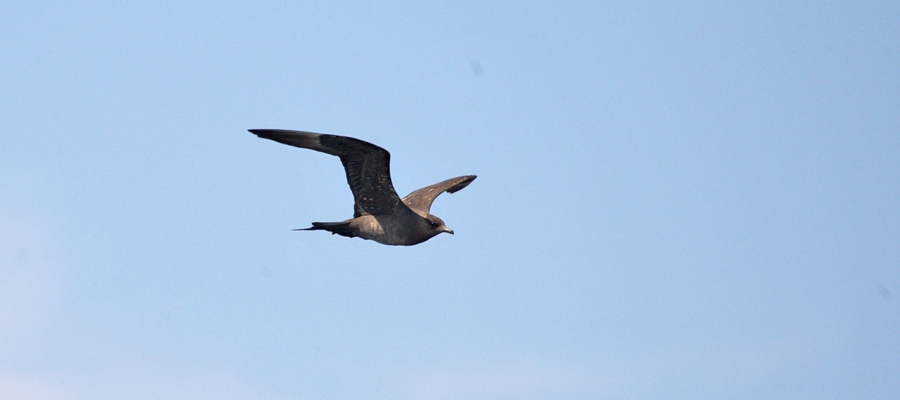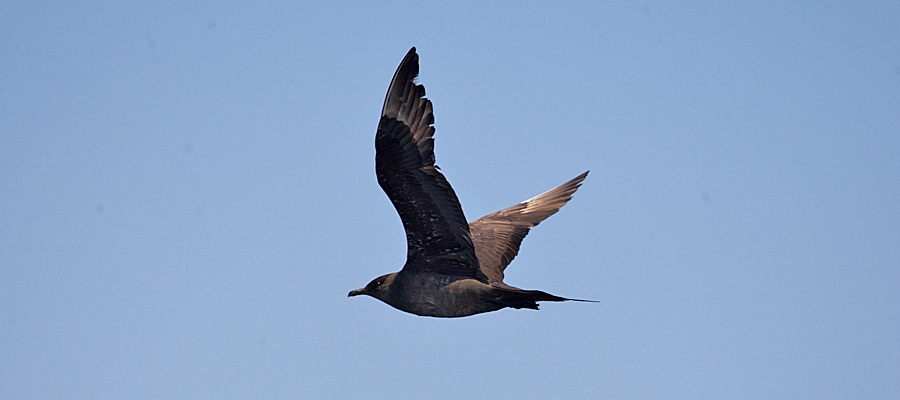JAEGERS and SKUAS
Predicting the abundance of Jeagers is very difficult. That being said, late Summer and Fall do tend to be the best time of year to see Jeagers off the Massachusetts coast… particularly after the Tern breeding season is finished and the skies are filled with migrating Terns. Jeagers, as you probably know, like to steal fish from other birds rather than hunt themselves (much more on this below…). Jeagers also are typical bullies in that they like to pick on smaller birds than themselves. Flocks of migrating Terns, therefore make a convenient target for hungry Jaegers!
JAEGERS
The two Jaeger species that frequent our area are the Parasitic Jaeger and the Pomarine Jaeger (Long-tailed Jaegers have been seen but are exceedingly rare). Both Pomarine and Parasitic are uncommon but regular migrants in the late summer and throughout the fall, with the Parasitic being slightly more common than Pomarine.Both of these birds have a “light phase” in which their plumage resembles that of Greater Shearwater, and a “dark phase” that looks much like the plumage of a Sooty Shearwater (or a very small South Polar Skua).Dark phase birds (which are less common than light phase birds) can be separated by overall size and shape (Pomarine is bigger, bulkier than Parasitic), and by the shape of the two central “retricies” or tail-feathers. In a Parasitic Jaeger the two central retricies are longer than the rest of the tail and are sharply pointed. In the Pomarine Jaeger the same two feathers are also longer than the rest of the tail but are twisted and have round tipsLight phase Jaegers can also be identified by the relative amount of a dark pigmentation which forms the breast band visible on the underside of the bird. Parasitic Jaegers have a weak, diffuse, usually broken breast band whereas the Pomarine has a heavy, dark, usually complete band.
SKUAS
The one Skua species that I have seen, the South Polar Skua, is a very rare offshore visitor that is nearly as large as our biggest Gulls but more robust overall. They have a nearly all dark plumage with white “flashes” on the wrist of each wing.South Polar Skuas, as their name implies, breed in Antarctica and only visit this part of the North Atlantic in small numbers. I have seen this species twice on a 7 seas Whale Watch: once in August 1988 on Stellwagen Bank, and again in June 2003 on Jeffrey’s Ledge.A SKUA BY ANY OTHER NAME…One of my favorite quotes about Skuas is from Dr. Bernie Gunn.
Dr. Gunn he once said:“Skuas are unlovely creatures, one hopes God feels affection for them because few people do. They are ruthless scavengers, nest close to penguin rookeries so they can steal eggs or young chicks, hover round seals with pups and may pick their eyes out. I never even shot one which shows either remarkable forbearance or dereliction of duty on my part. I cannot in my most generous moments believe that a world free of skuas would be all that worse off. My conscience is salved by the number of times I have biffed an ice-axe at one, not I regret, with much effect as several centuries of explorers biffing ice-axes at them has taught them to duck. ” I think this is one of the funnies things I have ever read. While I don’t dispute Dr. Gunn’s observations, here in the North Atlantic the sighting of any Skua is cause for much excitement.ADAPTATIONS TO LIFE AT SEA
Jaegers and Skuas are both “kleptoparasites”. This means that they sometimes harass other birds into dropping a fish that they have worked hard to catch and then the Jaeger then steals it.
The aptly-named Parasitic Jaeger seems to practice this feeding behavior more than other Jaeger species. During a kleptoparasitic attack (by either Jaeger species) the Jaeger will pursue a bird with a fish in its bill (or an obviously full crop) with a fast, direct flight that is reminiscent of a hunting falcon.The victim (aka “the bird with the fish”) will usually try and climb higher into the sky in order to escape. Jaegers, however, are very fast and agile fliers and will pursue their target relentlessly. They follow their potential victim high in the air getting closer and closer. They then use their heavy, hooked bills and raucous call into batter and intimidate the poor bird and cause it to abandon its catch… which is then, of course, taken by the Jaeger.
Jaegers can therefore often be located even from a great distance away simply by noticing one bird aggressively pursuing another bird higher and higher into the sky.Interestingly, Skuas use just the opposite approach. Skuas usually drop down from above and force their victim to the water’s surface in order to persuade them into giving up their fish. Larger Skuas have even been known to drown birds that refuse to give up their catch by biting their necks and holding their head underwater.This difference in behavior may be useful in separating dark phase Pomarine Jaegers from South Polar Skuas which can be similar in size and shape.



